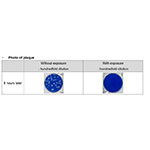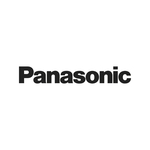OSAKA, Japan–(BUSINESS WIRE)–Panasonic Corporation today announced that the company, in collaboration with the Japan Textile Products Quality Technology Center, has verified the inhibitory effect of nanoe� on novel coronavirus adhering in a 24 m3 test space. This is the first time in the world that the inhibitory effect on adhered novel coronavirus has been verified in a test space almost as large as a daily living space.
nanoe� is a technology that collects invisible moisture in the air and applies a high voltage to it to produce �hydroxyl radicals contained in water�. Hydroxyl radicals inhibit the growth of pollutants such as bacteria and viruses. They are characterized by being strongly oxidative and highly reactive, hence a short life span. Contained in tiny water particles, nanoe� has a long lifespan and can spread around the space in a room. It has an inhibitory effect on both airborne and adhered substances.
The mutation of the amino acid in the spike protein has caused new variant strains with different infectivity, transmissibility, and antigenicity such as the increased binding capacity to cells and reduced binding to neutralizing antibodies. Consequently, the global spread of the novel coronavirus shows no sign of abating. Research is underway to identify the properties of the current dominant Omicron strain, but the increase in secondary infections in households and other factors suggest that its infectivity has increased compared to conventional strains, and further infection prevention measures are crucial.
Concerning the nanoe� technology, Panasonic verified their inhibitory effect on the novel coronavirus (SARS-CoV-2)*2 in July 2020 and its inhibitory effect on four novel coronavirus variants*3 in November 2021. The results of the previous tests were conducted in a small test space of 45-litres.
Therefore, Panasonic carried out a comparative experiment in a 24 m3 test space to compare virus titers with and without exposure to nanoe�. A piece of gauze saturated with the Delta strain of the novel coronavirus was exposed to nanoe� for 8 hours and the inhibitory effect of more than 99% was confirmed. Note that the verification results are based on a test in a closed test environment and not in space actually in use.
Panasonic will continue to pursue the potential of nanoe� technology and contribute to society by providing safer and more secure spaces.
? For reference
Testing the inhibitory effect of nanoe technology confirmed on the adhered novel coronavirus Delta variant (SARS-CoV-2) in a test space of approximately 24m3
? Overview
A comparative verification was conducted in a 24m3 test space containing the adhered novel coronavirus Delta variant (SARS-CoV-2)
? Results
The reduction in virus infection titer of more than 99% against the adhered novel coronavirus Delta variant (SARS-CoV-2) with the nanoe�technology was also verified in a 24 m3 test space.
Note: This verification was designed to generate basic research data on the effects of nanoe� on the novel coronavirus in laboratory conditions different from those found in living spaces.
? Results data
|
Test subject |
Time |
Inhibition rate |
|
Adhered novel coronavirus Delta variant (SARS-CoV-2) |
8 hours |
99.8% |
? Methodology and data
Organisation ?Japan Textile Products Quality and Technology Center (QTEC)
Subject ?Adhered novel coronavirus Delta variant (SARS-CoV-2)
Device ?nanoe� device
Method?
? In a test space of 24m3, (2700mm x 3640mm x 2450mm) place a piece of gauze saturated with the virus solution at a position 1.5m from nanoe� generator and 1.2m from the floor, and exposed to nanoe� (diffused into the test space by airflow from a blower installed on the wall).*4
? The virus infection titer is measured and the inhibition rate is calculated *5
? Principle of the generation of hydroxyl radicals
The atomization electrode is cooled by a Peltier element, which condenses moisture in the air to create water. Afterwards, a high voltage is applied across the atomization and the counter electrodes to generate �hydroxyl radicals contained in water� of approx. 5 to 20 nm in size.
*1 Regarding ion emission type air cleaning technology (As of March 1, 2022, surveyed by Panasonic)
*2 Verification of the inhibitory effect of hydroxyl radicals contained in water on the novel coronavirus (SARS-CoV-2) (Released in July 2020)
*3 Verification of the inhibitory effect of the nanoe technology on four feared mutant strains of the new coronavirus (released in November 2021). The titer of the new coronavirus and the four mutant strains showed the same decreasing trend regardless of the strain. The same results can be expected for mutant strains that may emerge in the future if tested under the same conditions in 45L.
*4 Based on “Test method for evaluating air purifiers’ performance in inhibiting viruses adhering indoors (established on July 4, 2011)” specified by the Japan Electrical Manufacturers’ Association
*5 Calculated by Panasonic
About Panasonic
Panasonic Corporation is a global leader developing innovative technologies and solutions for wide-ranging applications in the consumer electronics, housing, automotive, and B2B sectors. The company, which celebrated its 100th anniversary in 2018, operates 522 subsidiaries and 69 associated companies worldwide and reported consolidated net sales of 6,698.8 billion yen for the year ended March 31, 2021. Committed to pursuing new value through collaborative innovation, the company uses its technologies to create a better life and a better world for customers. Learn more about Panasonic: https://www.panasonic.com/global
# # #
Contacts
Media Contact
Tanya Houston – Wildwood PR
[email protected]
+44 (0)7711 617491

.jpg)






